Alfa Romeo MiTo 2014 Owner's Manual
Manufacturer: ALFA ROMEO, Model Year: 2014, Model line: MiTo, Model: Alfa Romeo MiTo 2014Pages: 280, PDF Size: 8.79 MB
Page 121 of 280
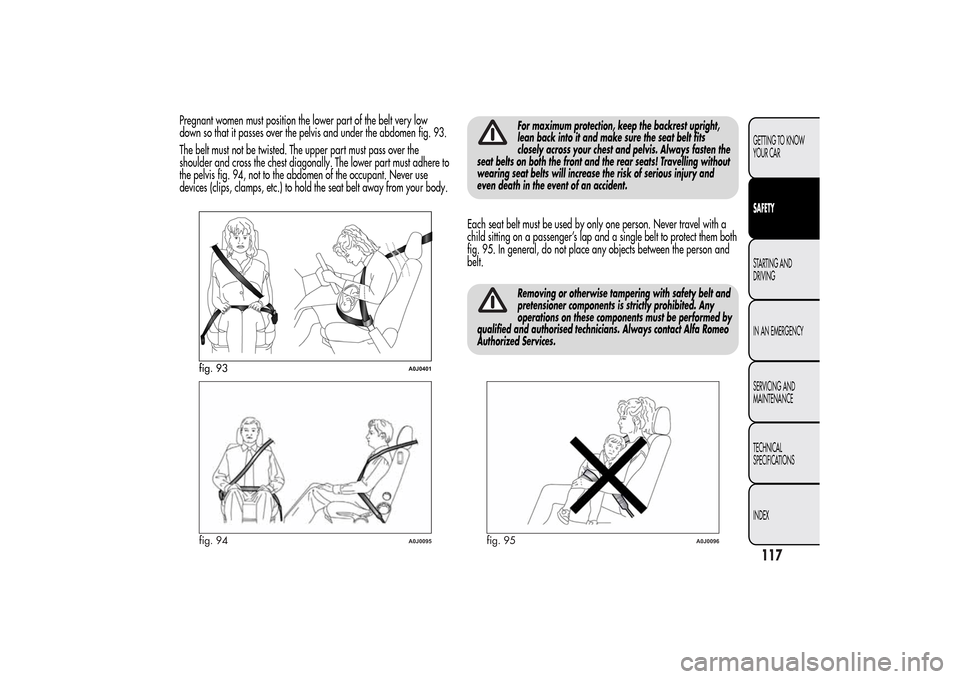
Pregnant women must position the lower part of the belt very low
down so that it passes over the pelvis and under the abdomen fig. 93.
The belt must not be twisted. The upper part must pass over the
shoulder and cross the chest diagonally. The lower part must adhere to
the pelvis fig. 94, not to the abdomen of the occupant. Never use
devices (clips, clamps, etc.) to hold the seat belt away from your body.
For maximum protection, keep the backrest upright,
lean back into it and make sure the seat belt fits
closely across your chest and pelvis. Always fasten the
seat belts on both the front and the rear seats! Travelling without
wearing seat belts will increase the risk of serious injury and
even death in the event of an accident.
Each seat belt must be used by only one person. Never travel with a
child sitting on a passengerŌĆÖs lap and a single belt to protect them both
fig. 95. In general, do not place any objects between the person and
belt.
Removing or otherwise tampering with safety belt and
pretensioner components is strictly prohibited. Any
operations on these components must be performed by
qualified and authorised technicians. Always contact Alfa Romeo
Authorized Services.
fig. 93
A0J0401
fig. 94
A0J0095
fig. 95
A0J0096
117GETTING TO KNOW
YOUR CARSAFETYSTARTING AND
DRIVING
IN AN EMERGENCY
SERVICING AND
MAINTENANCE
TECHNICAL
SPECIFICATIONS
INDEX
Page 122 of 280
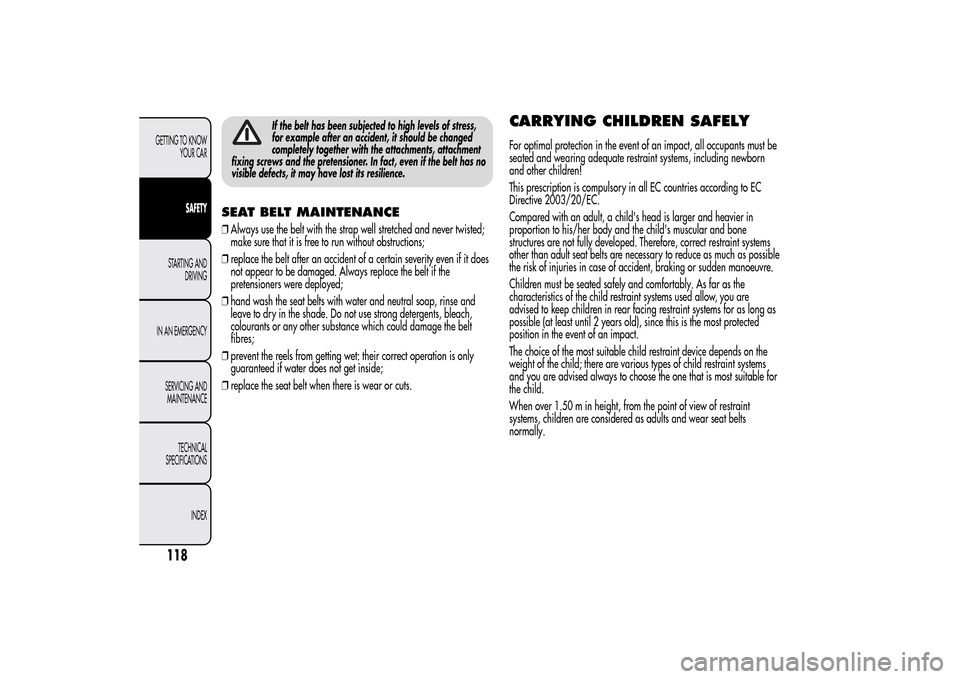
If the belt has been subjected to high levels of stress,
for example after an accident, it should be changed
completely together with the attachments, attachment
fixing screws and the pretensioner. In fact, even if the belt has no
visible defects, it may have lost its resilience.
SEAT BELT MAINTENANCEŌØÆAlways use the belt with the strap well stretched and never twisted;
make sure that it is free to run without obstructions;
ŌØÆreplace the belt after an accident of a certain severity even if it does
not appear to be damaged. Always replace the belt if the
pretensioners were deployed;
ŌØÆhand wash the seat belts with water and neutral soap, rinse and
leave to dry in the shade. Do not use strong detergents, bleach,
colourants or any other substance which could damage the belt
fibres;
ŌØÆprevent the reels from getting wet: their correct operation is only
guaranteed if water does not get inside;
ŌØÆreplace the seat belt when there is wear or cuts.
CARRYING CHILDREN SAFELYFor optimal protection in the event of an impact, all occupants must be
seated and wearing adequate restraint systems, including newborn
and other children!
This prescription is compulsory in all EC countries according to EC
Directive 2003/20/EC.
Compared with an adult, a child's head is larger and heavier in
proportion to his/her body and the child's muscular and bone
structures are not fully developed. Therefore, correct restraint systems
other than adult seat belts are necessary to reduce as much as possible
the risk of injuries in case of accident, braking or sudden manoeuvre.
Children must be seated safely and comfortably. As far as the
characteristics of the child restraint systems used allow, you are
advised to keep children in rear facing restraint systems for as long as
possible (at least until 2 years old), since this is the most protected
position in the event of an impact.
The choice of the most suitable child restraint device depends on the
weight of the child; there are various types of child restraint systems
and you are advised always to choose the one that is most suitable for
the child.
When over 1.50 m in height, from the point of view of restraint
systems, children are considered as adults and wear seat belts
normally.
118GETTING TO KNOW
YOUR CAR
SAFETY
STARTING AND
DRIVING
IN AN EMERGENCY
SERVICING AND
MAINTENANCE
TECHNICAL
SPECIFICATIONS
INDEX
Page 123 of 280
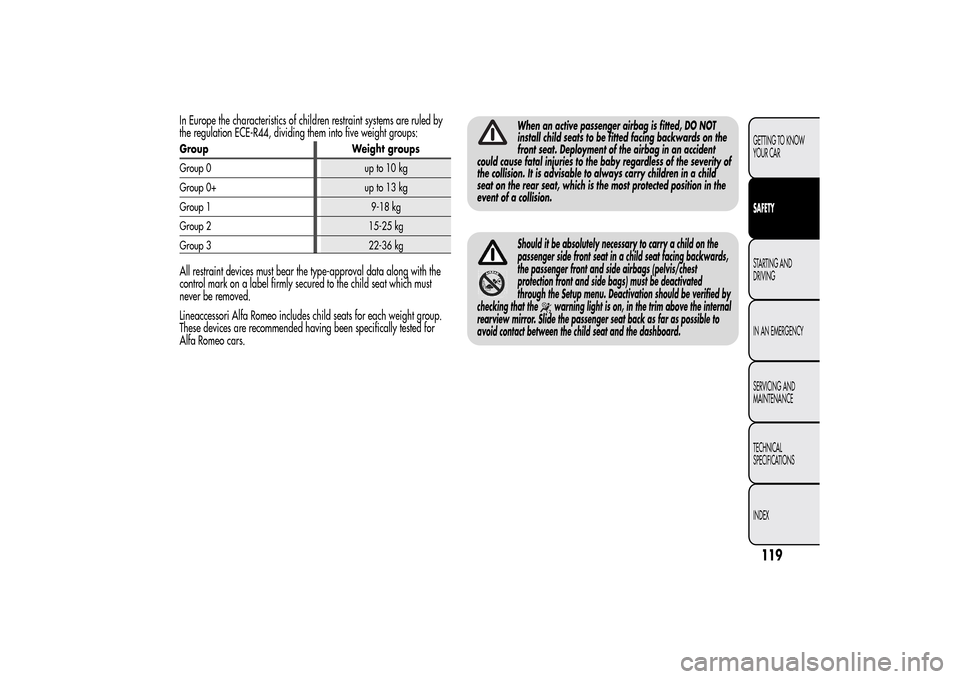
In Europe the characteristics of children restraint systems are ruled by
the regulation ECE-R44, dividing them into five weight groups:Group Weight groups
Group0 upto10kg
Group 0+ up to 13 kg
Group 1 9-18 kg
Group 2 15-25 kg
Group 3 22-36 kgAll restraint devices must bear the type-approval data along with the
control mark on a label firmly secured to the child seat which must
never be removed.
Lineaccessori Alfa Romeo includes child seats for each weight group.
These devices are recommended having been specifically tested for
Alfa Romeo cars.
When an active passenger airbag is fitted, DO NOT
install child seats to be fitted facing backwards on the
front seat. Deployment of the airbag in an accident
could cause fatal injuries to the baby regardless of the severity of
the collision. It is advisable to always carry children in a child
seat on the rear seat, which is the most protected position in the
event of a collision.Should it be absolutely necessary to carry a child on the
passenger side front seat in a child seat facing backwards,
the passenger front and side airbags (pelvis/chest
protection front and side bags) must be deactivated
through the Setup menu. Deactivation should be verified by
checking that the
warning light is on, in the trim above the internal
rearview mirror. Slide the passenger seat back as far as possible to
avoid contact between the child seat and the dashboard.
119GETTING TO KNOW
YOUR CARSAFETYSTARTING AND
DRIVING
IN AN EMERGENCY
SERVICING AND
MAINTENANCE
TECHNICAL
SPECIFICATIONS
INDEX
Page 124 of 280
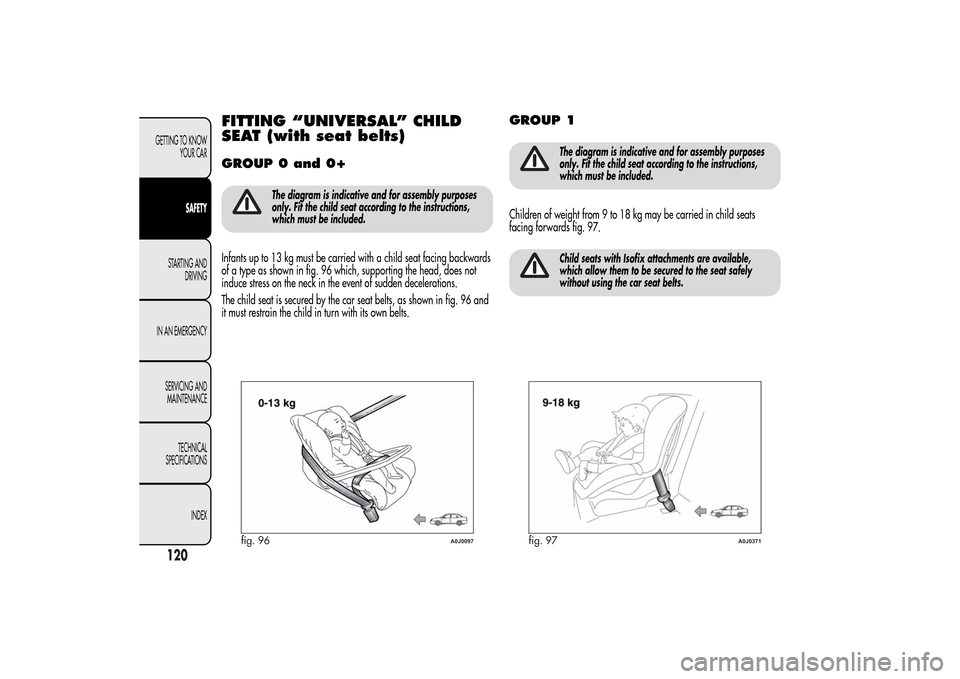
FITTING ŌĆ£UNIVERSALŌĆØ CHILD
SEAT (with seat belts)GROUP 0 and 0+
The diagram is indicative and for assembly purposes
only. Fit the child seat according to the instructions,
which must be included.
Infants up to 13 kg must be carried with a child seat facing backwards
of a type as shown in fig. 96 which, supporting the head, does not
induce stress on the neck in the event of sudden decelerations.
The child seat is secured by the car seat belts, as shown in fig. 96 and
it must restrain the child in turn with its own belts.
GROUP 1
The diagram is indicative and for assembly purposes
only. Fit the child seat according to the instructions,
which must be included.
Children of weight from 9 to 18 kg may be carried in child seats
facing forwards fig. 97.
Child seats with Isofix attachments are available,
which allow them to be secured to the seat safely
without using the car seat belts.
fig. 96
A0J0097
fig. 97
A0J0371
120GETTING TO KNOW
YOUR CAR
SAFETY
STARTING AND
DRIVING
IN AN EMERGENCY
SERVICING AND
MAINTENANCE
TECHNICAL
SPECIFICATIONS
INDEX
Page 125 of 280
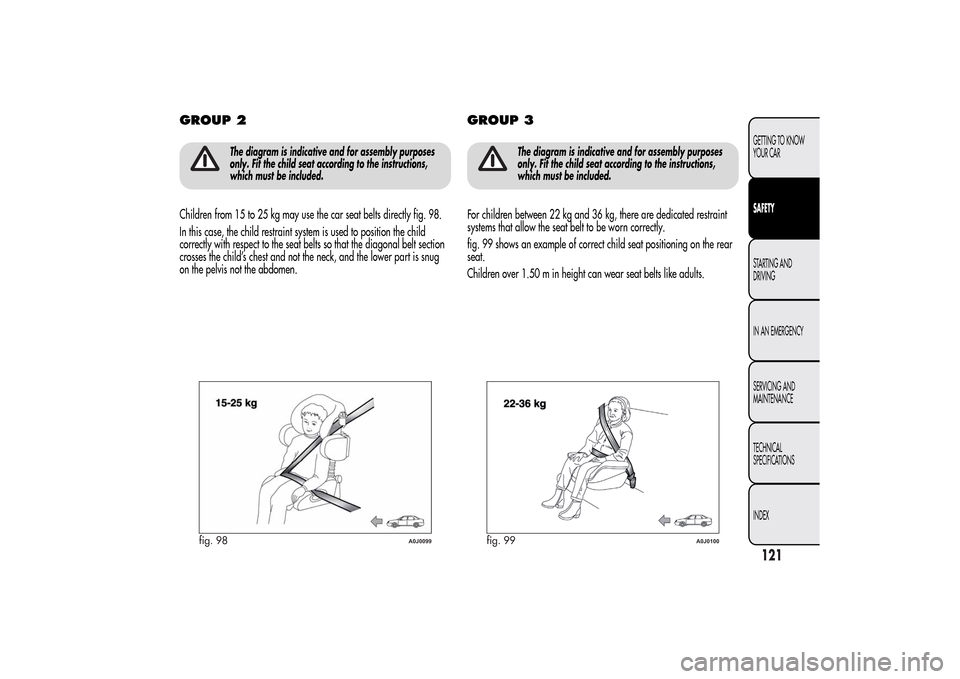
GROUP 2
The diagram is indicative and for assembly purposes
only. Fit the child seat according to the instructions,
which must be included.
Children from 15 to 25 kg may use the car seat belts directly fig. 98.
In this case, the child restraint system is used to position the child
correctly with respect to the seat belts so that the diagonal belt section
crosses the childŌĆÖs chest and not the neck, and the lower part is snug
on the pelvis not the abdomen.
GROUP 3
The diagram is indicative and for assembly purposes
only. Fit the child seat according to the instructions,
which must be included.
For children between 22 kg and 36 kg, there are dedicated restraint
systems that allow the seat belt to be worn correctly.
fig. 99 shows an example of correct child seat positioning on the rear
seat.
Children over 1.50 m in height can wear seat belts like adults.
fig. 98
A0J0099
fig. 99
A0J0100
121GETTING TO KNOW
YOUR CARSAFETYSTARTING AND
DRIVING
IN AN EMERGENCY
SERVICING AND
MAINTENANCE
TECHNICAL
SPECIFICATIONS
INDEX
Page 126 of 280
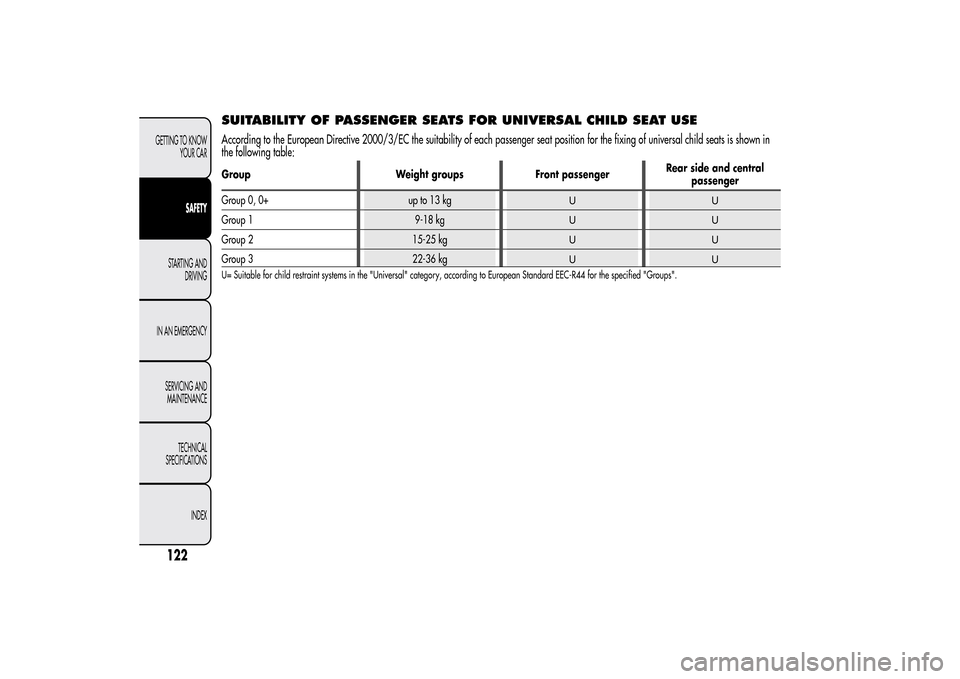
SUITABILITY OF PASSENGER SEATS FOR UNIVERSAL CHILD SEAT USEAccording to the European Directive 2000/3/EC the suitability of each passenger seat position for the fixing of universal child seats is shown in
the following table:Group Weight groups Front passengerRear side and central
passenger
Group 0, 0+ up to 13 kg
UU
Group 1 9-18 kg
UU
Group 2 15-25 kg
UU
Group 3 22-36 kg
UU
U= Suitable for child restraint systems in the "Universal" category, according to European Standard EEC-R44 for the specified "Groups".
122GETTING TO KNOW
YOUR CAR
SAFETY
STARTING AND
DRIVING
IN AN EMERGENCY
SERVICING AND
MAINTENANCE
TECHNICAL
SPECIFICATIONS
INDEX
Page 127 of 280
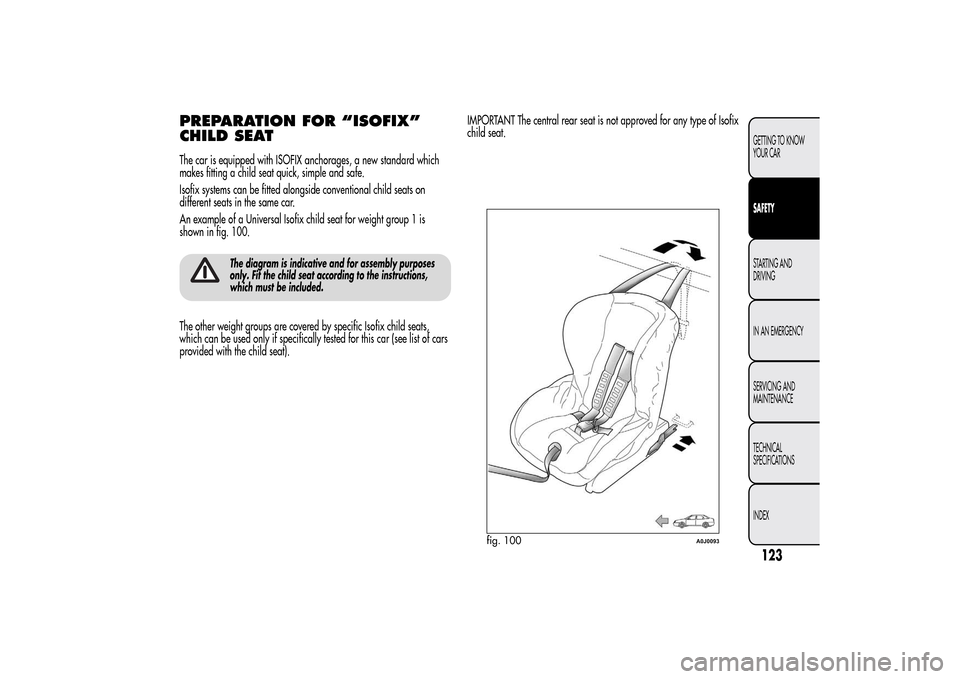
PREPARATION FOR ŌĆ£ISOFIXŌĆØ
CHILD SEATThe car is equipped with ISOFIX anchorages, a new standard which
makes fitting a child seat quick, simple and safe.
Isofix systems can be fitted alongside conventional child seats on
different seats in the same car.
An example of a Universal Isofix child seat for weight group 1 is
shown in fig. 100.
The diagram is indicative and for assembly purposes
only. Fit the child seat according to the instructions,
which must be included.
The other weight groups are covered by specific Isofix child seats,
which can be used only if specifically tested for this car (see list of cars
provided with the child seat).IMPORTANT The central rear seat is not approved for any type of Isofix
child seat.
fig. 100
A0J0093
123GETTING TO KNOW
YOUR CARSAFETYSTARTING AND
DRIVING
IN AN EMERGENCY
SERVICING AND
MAINTENANCE
TECHNICAL
SPECIFICATIONS
INDEX
Page 128 of 280
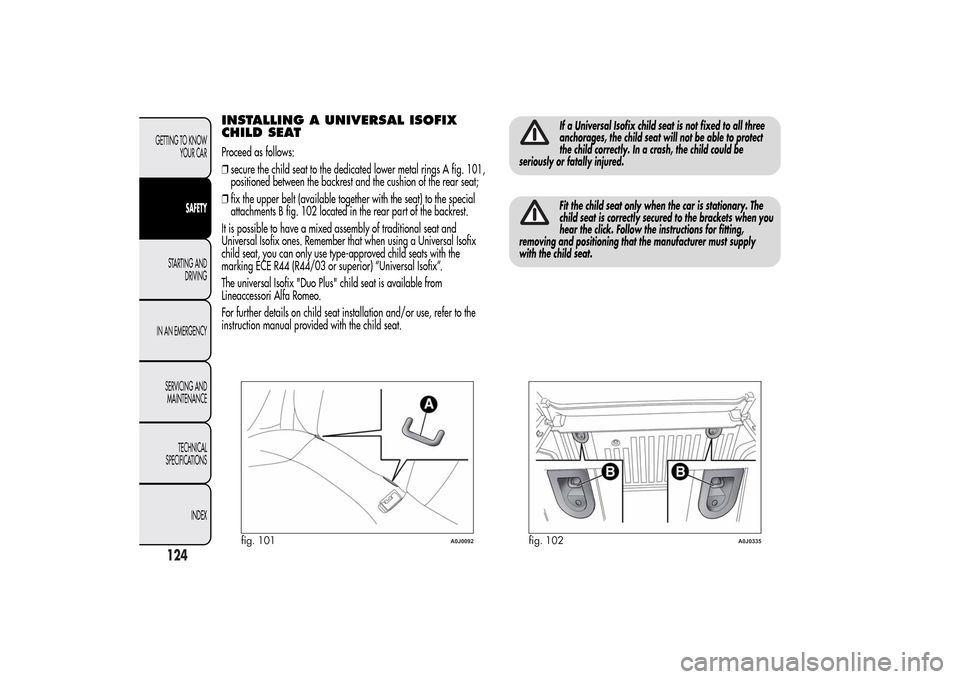
INSTALLING A UNIVERSAL ISOFIX
CHILD SEATProceed as follows:
ŌØÆsecure the child seat to the dedicated lower metal rings A fig. 101,
positioned between the backrest and the cushion of the rear seat;
ŌØÆfix the upper belt (available together with the seat) to the special
attachments B fig. 102 located in the rear part of the backrest.
It is possible to have a mixed assembly of traditional seat and
Universal Isofix ones. Remember that when using a Universal Isofix
child seat, you can only use type-approved child seats with the
marking ECE R44 (R44/03 or superior) ŌĆ£Universal IsofixŌĆØ.
The universal Isofix "Duo Plus" child seat is available from
Lineaccessori Alfa Romeo.
For further details on child seat installation and/or use, refer to the
instruction manual provided with the child seat.
If a Universal Isofix child seat is not fixed to all three
anchorages, the child seat will not be able to protect
the child correctly. In a crash, the child could be
seriously or fatally injured.Fit the child seat only when the car is stationary. The
child seat is correctly secured to the brackets when you
hear the click. Follow the instructions for fitting,
removing and positioning that the manufacturer must supply
with the child seat.
fig. 101
A0J0092
fig. 102
A0J0335
124GETTING TO KNOW
YOUR CAR
SAFETY
STARTING AND
DRIVING
IN AN EMERGENCY
SERVICING AND
MAINTENANCE
TECHNICAL
SPECIFICATIONS
INDEX
Page 129 of 280
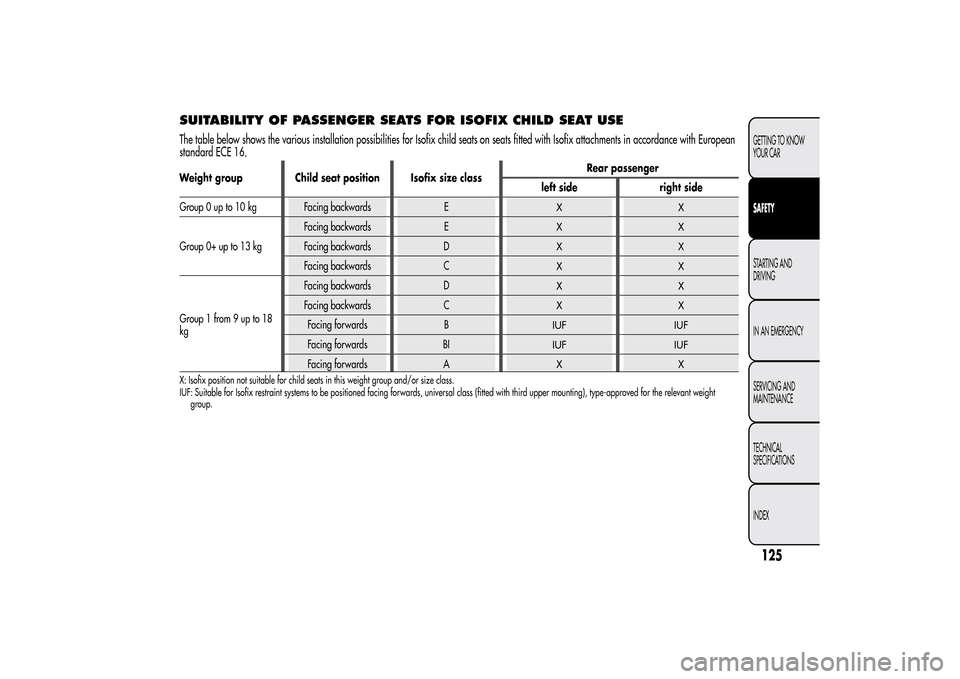
SUITABILITY OF PASSENGER SEATS FOR ISOFIX CHILD SEAT USEThe table below shows the various installation possibilities for Isofix child seats on seats fitted with Isofix attachments in accordance with European
standard ECE 16.Weight group Child seat position Isofix size classRear passenger
left side right side
Group 0 up to 10 kg Facing backwards E
XX
Group 0+ up to 13 kgFacing backwards E
XX
Facing backwards D
XX
Facing backwards C
XX
Group 1 from 9 up to 18
kgFacing backwards D
XX
Facing backwards C
XX
Facing forwards B
IUF IUF
Facing forwards BI
IUF IUF
Facing forwards A
XX
X: Isofix position not suitable for child seats in this weight group and/or size class.
IUF: Suitable for Isofix restraint systems to be positioned facing forwards, universal class (fitted with third upper mounting), type-approved forthe relevant weight
group.
125GETTING TO KNOW
YOUR CARSAFETYSTARTING AND
DRIVING
IN AN EMERGENCY
SERVICING AND
MAINTENANCE
TECHNICAL
SPECIFICATIONS
INDEX
Page 130 of 280
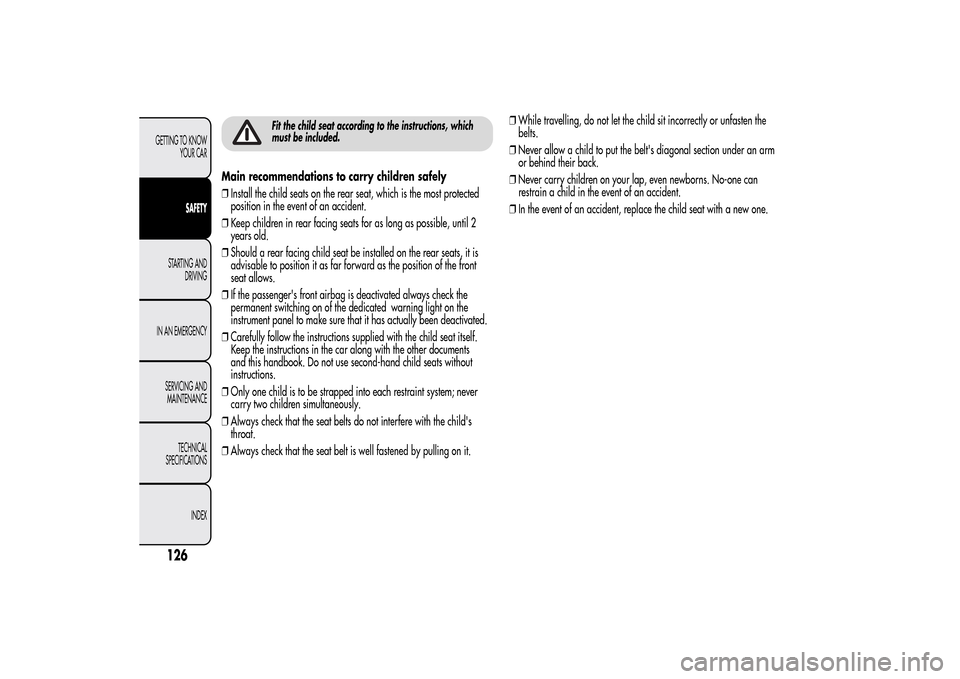
Fit the child seat according to the instructions, which
must be included.
Main recommendations to carry children safely
ŌØÆInstall the child seats on the rear seat, which is the most protected
position in the event of an accident.
ŌØÆKeep children in rear facing seats for as long as possible, until 2
years old.
ŌØÆShould a rear facing child seat be installed on the rear seats, it is
advisable to position it as far forward as the position of the front
seat allows.
ŌØÆIf the passenger's front airbag is deactivated always check the
permanent switching on of the dedicated warning light on the
instrument panel to make sure that it has actually been deactivated.
ŌØÆCarefully follow the instructions supplied with the child seat itself.
Keep the instructions in the car along with the other documents
and this handbook. Do not use second-hand child seats without
instructions.
ŌØÆOnly one child is to be strapped into each restraint system; never
carry two children simultaneously.
ŌØÆAlways check that the seat belts do not interfere with the child's
throat.
ŌØÆAlways check that the seat belt is well fastened by pulling on it.ŌØÆWhile travelling, do not let the child sit incorrectly or unfasten the
belts.
ŌØÆNever allow a child to put the belt's diagonal section under an arm
or behind their back.
ŌØÆNever carry children on your lap, even newborns. No-one can
restrain a child in the event of an accident.
ŌØÆIn the event of an accident, replace the child seat with a new one.
126GETTING TO KNOW
YOUR CAR
SAFETY
STARTING AND
DRIVING
IN AN EMERGENCY
SERVICING AND
MAINTENANCE
TECHNICAL
SPECIFICATIONS
INDEX